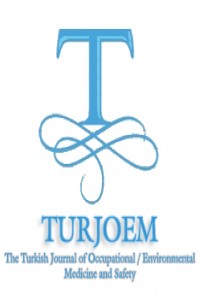NMR-BASED METABOLOMICS APPROACH TO STUDY THE TOXICITY OF ACETAMIPRID-BASED INSECTICIDE TO GAMBUSIA HOLBROOKI
Öz
In this study, a
1H nuclear magnetic resonance (NMR) based metabolomics approach was
applied to investigate the toxicity of acetamiprid) in Gambusia holbrooki (Mosquitofish). Acetamiprid is commonly used
both in agriculture and domestic areas against a wide range of insects that have gained resistance to other pesticides such
as organophosphate, carbamate and
pyrethroid.
The commercial
formulation of acetamiprid (RastT 20 SP) supplied from a local agricultural
pest store, were used in this study. Static renewal acute toxicity tests were
performed in glass dishes containing 5 L test solution with 10 fish/vessel.
Initially, the 96-h LC50value of acetamiprid was estimated for G. holbrooki.
Sublethal concentrations of tested pesticide were applied (1/2, 1/5 and 1/10of 96-hLC50value)
for 96-h.
The 24-h, 48-h, 72-h, 96-h LC50
value were determined for Acetamiprid was as 75.9, 54.1, 48.5, 42.2 mg active ingredient/L respectively. 1H NMR spectra of acetamiprid is recorded for its solution in CDCl3
and D2O. The obtained signals suggest the signals thermodynamically
not stable. The NMR spectra in CDCl3 could be taken more easily
because of the higher solubility in this solvent. Another advantage of this
solvent was the absence of signal overlapping around 3.4, 3.5 and 3.8 ppm The
signals in D2O are more complex because of signal overlapping around
3.1 ppm.
Anahtar Kelimeler
Kaynakça
- Science Faculty, Department of Biology, Dicle University, Turkey
- Gebze Institute of Technology, Kocaeli, Turkey
- Science Faculty, Department of Chemistry, Dicle University, Turkey
Öz
Kaynakça
- Science Faculty, Department of Biology, Dicle University, Turkey
- Gebze Institute of Technology, Kocaeli, Turkey
- Science Faculty, Department of Chemistry, Dicle University, Turkey
Ayrıntılar
| Bölüm | Articles |
|---|---|
| Yazarlar | |
| Yayımlanma Tarihi | 16 Şubat 2017 |
| Yayımlandığı Sayı | Yıl 2017 Cilt: Volume 2 Sayı: İssue 1 (1) - 2.İnternational Congress Of Forensic Toxicology |


